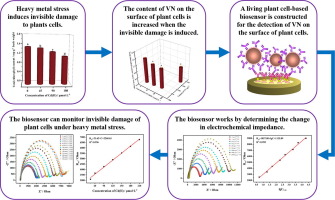黄晓华教授课题组在SCIENCE OF THE TOTAL ENVIRONMENT发表研究论文
A living plant cell-based biosensor for real-time monitoring invisible damage of plant cells under heavy metal stress
Wang, X (Wang, Xiang)[ 1 ] ; Cheng, MZ (Cheng, Mengzhu)[ 1 ] ; Yang, Q (Yang, Qing)[ 1 ] ; Wei, HY (Wei, Haiyan)[ 1 ] ; Xia, A (Xia, Ao)[ 1 ] ; Wang, LH (Wang, Lihong)[ 2 ] ; Ben, Y (Ben, Yue)[ 1 ] ; Zhou, Q (Zhou, Qing)[ 2 ] ; Yang, ZB (Yang, Zhenbiao)[ 3 ] ; Huang, XH (Huang, Xiaohua)[ 1 ](黄晓华)*
[ 1 ] Nanjing Normal Univ, Natl & Local Joint Engn Res Ctr Biomed Funct Mat, Jiangsu Collaborat Innovat Ctr Biomed Funct Mat, Sch Chem & Mat Sci, Nanjing 210023, Jiangsu, Peoples R China
[ 2 ] Jiangnan Univ, State Key Lab Food Sci & Technol, Wuxi 214122, Jiangsu, Peoples R China
[ 3 ] Univ Calif Riverside, Ctr Plant Cell Biol, Inst Integrat Genome Biol, Dept Bot & Plant Sci, Riverside, CA 92521 USA
SCIENCE OF THE TOTAL ENVIRONMENT,201912,697
Heavy metals inevitably cause invisible or visible damage to plants, leading to significant economic losses. Therefore, it is necessary to develop a method for timely monitoring the damage of plants under the stress of heavy metals. Here, vitronectin-like proteins (VN) on the surface of plant cells is as an important biomarker for monitoring damage of plants under the stress of heavy metals. A living plant cell-based biosensor is constructed to monitor invisible damage of plant cells induced by cadmium [Cd(II)] or lead [Pb(II)]. To fabricate this sensor, L-cysteine was first modified on the glassy carbon electrode followed by the modification of anti-IgG-Au antibody. Then, the living plant cells, incubated with the anti-VN, were modified onto the electrode. The sensor worked by determining the change in electrochemical impedance. Cd(II) and Pb(II) was detected in the linear dynamic range of 45-210 and 120-360 mu mol.L-1, respectively. And the detection limit of Cd(II) and Pb(II) of this biosensor was 18.5 nmol.L-1 [with confidence interval (95%) 18.4-18.6 nmol.L-1] and 25.6 nmol.L-1 [with confidence interval (95%) 25.4-25.8 nmol.L-1], respectively. In both Arabidopsis and soybean, when the content of VN increased by about 20 times under the stress of Cd(II) or Pb(II), which means when the electron-transfer resistance increased by 35%, chlorophyll content showed significant decrease about 17%. Therefore, by establishing a quantitative relationship among the content of biomarker, the electron-transfer resistance and chlorophyll content in plant cells, the invisible damage of plants under the stress of heavy metals was detected. These results can provide a reference method for early-onset warning systems for heavy metal pollution in the environment.

文章链接:
https://www.sciencedirect.com/science/article/pii/S0048969719340744?via%3Dihub
版权与免责声明:本网页的内容由收集互联网上公开发布的信息整理获得。目的在于传递信息及分享,并不意味着赞同其观点或证实其真实性,也不构成其他建议。仅提供交流平台,不为其版权负责。如涉及侵权,请联系我们及时修改或删除。邮箱:sales@allpeptide.com